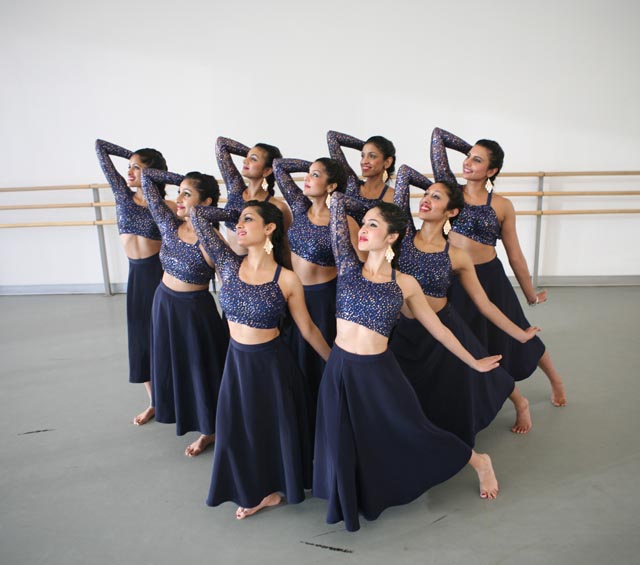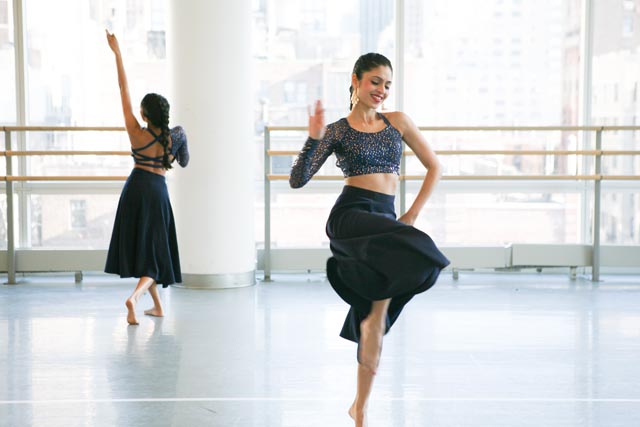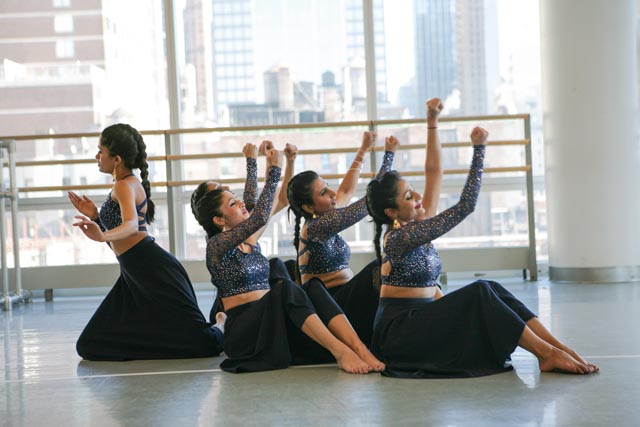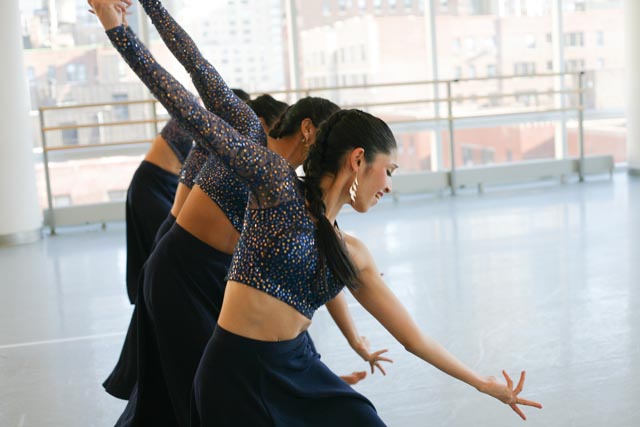
Celebrating East & West – SA Dance Company
Can you appropriate two worlds? Or to put it less elegantly, can you eat your cake and have it too? The Sa Dancers once again prove that you can, shifting effortlessly as they do between the world of business and the world of fabulous dance. Their latest studio showcase at the Alvin Ailey Theater showed how effortlessly they mix their roots and faraway homelands with the here and now of frenetic New York.
The SA Dance Company took an audience of over 200 people on a journey into Indian villages, sitting on an imaginary slow-moving boat, then to Mughal India, and yes, out into the pouring Indian monsoon. The music was a wonderful blend of folk and Bollywood, modern and pop and the dance steps spawned from many different choreographies created a pattern all their own. The pieces they presented included Sonia’s Words, Our Roots, Rain Down on Us and Inseparation, in which popular and folk music is used to great effect.
“The pieces in any of our showcase always evolve over time but much of it comes from what inspires me in my daily life, new – and sometimes old – music I hear, performances I see and most importantly, the dancers in the company,” says Payal Kadakia, the artistic director and choreographer of Sa Dancers.
Having grown up in the US, Kadakia is influenced by western dance although she was trained from childhood in Indian folk and classical styles, often participating in community dance competitions. ” I also really enjoy going from contemporary movements right into more traditional indian steps or contrasting the styles in the same step by adding a mudra in the hand or expression in the face but having the body flow in a more unstructured, modern way.”
How much of Indian and western dance does she mix together? “It may not be explicitly seen since the music is Indian but the American identity will always remain in the essence of SA,” she says. “In this show I also brought in a trained contemporary dancer to further highlight the beauty of American dancing and contrast it to the Indian style.”
Dance is Music Made Visible
For Kadakia, it all begins with the music which is the germ, the sprout for everything else. She says, ” My mind just starts choreographing without me even realizing. One of my favorite pieces, The Boatman, came together when I was walking to practice listening to my iPod. I was so touched by the music and immediately just imagined a group of people rowing and I choreographed the entire piece in my ten block walk to practice.
I know all the girls remember that day. I walked in and told everyone to get into a boat-like formation and row as I played the music. It was so inspirational that one of the dancers, Sonia Mukherji, wrote a poem based on the piece, which we opened the segment with.”
Indeed, bits and pieces of the music shape out the choreography and lead to a new creation: “I love breaking down the elements of a song and portraying those pieces through the dancers. I’ll have one dancer dance to the drums, another to the flute in the background and another dancing to the voice. One of my favorite quotes by Morocco that I think really reflects how I choreograph is ‘The audience’s ears hear the music, and their eyes see you being that music. Dance is the music made visible. You ARE the music!'”
In this performance the music was as diverse as The Boatman by Nitin Sawney, Azeem O Shaan from Jodha Akbar, Aarti by AR Rahman as well as original Rajasthani and Garba folk music.
The dancers fan out in diverse ways, like the pieces of glass forming different patterns within a kaleidoscope. In some dances, says Kadakia, ” We are a unit working together. This piece cannot work without any one of us. In others, like ‘Rain Down on Me,’ we’re not all one unit really – we can showcase our individual characters.”

SA Dancers: Between Two Worlds
The dancers in SA have all grown up in America but their roots are in India. Every dancer is trained in one or more styles of dance so they are disciplined and aware of their bodies, be it Kathak, Bharatanatyam, Kuchipudi, Odissi, Folk, Ballet or Jazz. What is remarkable is that they do this while holding down challenging jobs in the corporate world.
Payal Kadakia is the CEO and founder a new tech startup called Classtivity; she says: ” I can’t separate myself from dance – Dance is life and life is dance. It’s always a part of me whether I know it or not. It has made me who I am in every aspect of my life from my career to my relationships. I’m grateful to have been given such a gift and to be able to share it with others through SA.”
Kanika Chadda is a producer for Zee TV Americas and has also been Entertainment Anchor for the CNN Affiliate in Mumbai, interviewing big names like Hrithik Roshan and Ranbir Kapoor. Chaddha who began training with Smt. Anuradha Nehru in Kuchipudi in Washington DC at the age of 5 has undergone rigorous training in summer dance camps under her guruji’s guru, the late Vempati Chinna Satyam.
She says, “Over the years, as I’ve matured, dance has evolved into a form of catharsis, of release, of meditation, and of daily prathna. SA ignites these sentiments each time we meet to practice in a dance studio or when we’re on stage. I love that each of us has trained in different art forms (Odissi, Kathak, Kuchipudi, Bharatanatyam, and Folk) since there’s an amalgamation of movements and abhinaya that is so unique to SA.”

A Passion for Indian Music & Dance
This being New York, home of Wall Street, several of the dancers work in the financial world.
Bhavika Kapadia Patel currently is a Director at FTI Consulting, Inc, which is a Forensic and Litigation Consulting Firm. “There was a span of a few years where I did not dance at all and it definitely felt like something was missing in my life,” says Patel who recently got married. “Trying to adjust to married life, hectic work schedules, and practices for the SA show were definitely a challenge at times, but I still managed to make each and every one of those important part of my life a priority. This would not have been possible without the support of my husband, who has been absolutely wonderful in encouraging me the last few months.”
Asked as to why dance is so important to her, she quotes Jaques D’ambroise. ” Dance is your pulse, your heartbeat, your breathing. It’s the rhythm of your life. It’s the expression in time and movement, in happiness, joy, sadness and envy.”
Nitika Gaiha, director of the Sa Dancers, is also involved with the financial world. She says, “New York is one of the best places to grow in finance, which is why my “real life” job has me doing research for a hedge fund.” Ask her about dance and she gets emotional: “Dance is my yoga, my refuge, my exercise, and my gift that I must cherish to one day give back to others. It is a way of life which allows me to immerse myself in music, learn about my culture, and be a part of a 5000-year-old art form. Like yoga, dance puts me in a reflective mood. It allows me to look beyond my day-to-day struggles to develop a strong sense of identity and purpose. Just as teachers taught me this way of life, I hope to share it with others to provide them with the same outlets of reflection and expression which I have been lucky to have in my life.”

Dance Is As Necessary as Eating & Sleeping
Sonia Mukherji works in Asset Management but dance is a daily feature for her – as monumental as sleeping or eating – because she has been dancing since she was four years old. She says, “I am not only enthralled with what the body can do from a technical aspect, but also in love with the innovative vision that informs all aspects of the life of the dancer. A dancer is thinking and creating dance even when they are not dancing. SA is that evolution, that vision; I am a body expressing it.”
Rashi Birla is a freelance graphic designer and runs her own small design business. Why SA? She says: “When I dance, I’m the best version of myself. Dance and performing on stage brings out the best in me. In real life, I’m a bit more subdued and don’t express emotion very much, so dance is my way of expressing my heart to the world. Dancing on stage gives me an inexplicable and irreplaceable high that I wouldn’t give up for anything.”
Indeed most of these dancers start early, are fed dance with their cookies and milk and it becomes a part of their DNA. Avani Shah, a second year law student at Hofstra Law School, recalls: ” I enjoyed it because it meant I had a chance to dress up and hang out with my friends. A few years later, it was because I wanted to be just like my favorite Bollywood actress and dancer Madhuri Dixit. However, over time that enjoyment grew into something deeper and so much more profound; passion. Today, I dance to lose myself to the magic of the music, choreography, and the emotions attached with each individual piece.”
Perhaps her explanation explains the addiction to dance: “When I am dancing I forget that it is a performance. Dance allows me to be transported to the world of the characters I am expressing and I am no longer Avani the law student. For those moments I am the young bride getting ready for her marriage, or the devotee consumed by her love for the Divine, or the soldier going off to war , never to return. Dance is my biggest passion and something I hope to be able to continue doing for the rest of my life.”
From a student – to a teacher, SA has them all. Sona Thaker teaches first grade in New Jersey – and she started dancing when she was just three years old! “I started in the same group as Sa’s founder, Payal Kadakia. We grew up dancing together in many competitions and various different venues. When I wasn’t dancing I always felt like something was missing.
Once I moved closer to NY I joined SA and that feeling was gone, I felt fulfilled. Now more than ever, dance feels like a way to express ourselves and bring smiles to people’s faces. It creates a positive energy that is shared by all that are able to experience it and especially among the dancers who share the stage. It’s an amazing feeling.”
Ashvini Thammaiah recently joined the executive development rotational program at LexisNexis after graduating from Harvard Business School. Asked as to what puts the SA into her life, she says, “To me, dance is a world full of expression, art, and challenges — each piece presents the opportunity to illustrate a new feeling, each movement is an expression of beauty, and each day offers my body a way to give more.”
And that is what dance is all about – giving of yourself. Hand gestures, feet pirouetting, faces smiling and sad, all moving together, creating so many different worlds, giving so much pleasure to audiences. For the SA Dancers, their performances are not a commercial venture so they do it for the love of dancing – and because they must.
Asked about her hopes for the SA Dancers, Payal Kadakia, says that dance is a vital part of their lives and always has been: “As we continue to take on more responsibilities in our lives whether at home or in the workplace, I hope we all always remember to keep our connection to dance alive. We all know how much joy it brings to us so it should always remain a part of who we are. It makes us shine as human beings – inside and out.”
Related Articles
Sa Sensational!
Indian Dance – Out of the Box
